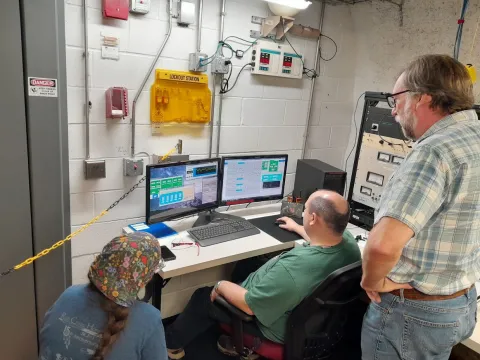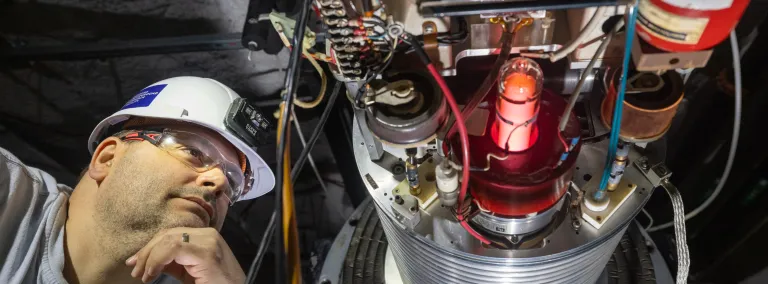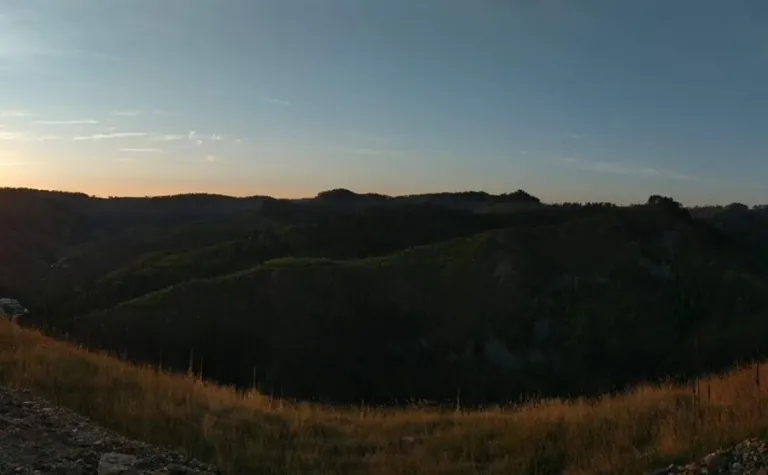CASPAR’s first beam: particle accelerator restart at SURF opens a new chapter of discovery
The Compact Accelerator System for Performing Astrophysical Research (CASPAR) allows researchers to study the forging of elements inside stars. The experiment recently restarted, after about four years of hibernation.
We know the universe began with hydrogen, helium, and a trace of lithium.
Every other atom—from the iron in our blood to the silicon in our phones—was forged in stars.
This fact is both astonishing and a bit humbling. We know the stars made us, but we don’t fully understand how.
Each element has its own complex stellar recipe, and beneath nearly a mile of rock, at the Sanford Underground Research Facility (SURF) in South Dakota, researchers use CASPAR to mimic the furnaces inside stars and unravel the intricate processes by which we were formed.
CASPAR simulates the reactions inside of stars by hurling a particle beam at a target and capturing the interactions. The relatively small and low-energy underground accelerator measures about 50 feet long. The beam dissipates roughly 100 watts of power into the target, in the same range of a light bulb—but these small interactions lend a great deal of insight.
Dan Robertson is a research professor in the Department of Physics & Astronomy at the University of Notre Dame, the technical coordinator for CASPAR, and one of the principal investigators on the project.
“We're trying to see how the fundamental elements, the building blocks of life, were created. To do this, we work to isolate the individual reactions, how they happen, how fast they happen, and what products are produced. Ultimately, we want to understand how we came into being from the inside of a star,” Robertson said.
Researchers at CASPAR don’t tackle these questions alone—they collaborate with astronomers and theoretical physicists around the world.
“CASPAR is basically a mile underground and we are reproducing what an astronomer looking though a telescope at the top of a mountain is seeing. Experimentalists, like those of us at CASPAR, take information from astronomers and theorists, and then reproduce what they see or what they come up with. So, it's a beautiful cycle. We go back and forth trying to pin down the exact interactions that take place,” Robertson said.
CASPAR is coming off a hibernation imposed during the construction and blasting needed to produce the large underground laboratory space for the Deep Underground Neutrino Experiment (DUNE) at SURF. The restart means those working on this experiment, like Mark Hanhardt, are closer to filling some of the most profound gaps in our cosmic lineage.

“Getting the chance to explore what is really, literally the chemical lineage of us, using this system to understand how the stars took simple hydrogen and helium and created more complex, heavier atoms that make our universe possible—it's really fulfilling, and it's exciting to be involved,” Hanhardt said.
Hanhardt is an experiment support scientist at SURF and a Ph.D. candidate at South Dakota Mines. He and others in this field of work recognize some of these profound questions might take more than a lifetime of work to answer. For this reason, CASPAR’s goals also include educating the next generation of researchers. Olivia Cantrell, an undergraduate student of physics at New Mexico Tech, spent part of her summer as an intern working on CASPAR; she is excited for the future of this field of study.
“I love answering the big questions. I feel like life is too short to kind of spend time living content not knowing the answers to everything. So, spending my life attempting to solve some of the questions in the universe would be really fulfilling to me, because this is so exciting,” Cantrell said.
Students working on CASPAR don’t just look at data and ask big questions all day. They also get their hands dirty. Robertson says students are tasked to turn wrenches, run wires, and do all the maintenance required to make this accelerator run.
“One of the things that we say at CASPAR is, ‘if you don't understand where the particles you produced came from, you can't understand the data that comes out the other end,’ said Robertson. “Students are involved from the ground up, because it's their experiment, they have to take ownership of it. The fundamental understanding of what the data looks like is really enhanced by knowing where it came from.”
Logan Butsavage, a physics major at South Dakota Mines, recognizes the incredible value in working on an experiment of this caliber as an undergraduate. “CASPAR helps us build relationships with professors, graduate students, and research scientists who are working here at SURF,” Butsavage said. “Getting to know people in the field of physics can open doors for future careers or graduate school.”
Those like Hanhardt find great reward in rubbing shoulders with both students and colleagues on this word-class experiment.
“You literally get to build a machine that plucks mysteries out of the fabric of the universe, and then you get to see that come up on the screen and see that data. Someone once said, ‘god is in the data,’ you get to see the mystery, the gears, the clockwork of the Universe, and then, you get to tell the world about it,” Hanhardt said.
With its first beam, CASPAR does more than restart an experiment—it reopens a window onto the hidden story of creation. Every successful run brings scientists closer to understanding how the cosmos transformed simple hydrogen and helium into everything we know: the oxygen we breathe, the calcium in our bones, the gold in a wedding ring. The mystery of our origins may be illusive, but step by step, beam by beam, CASPAR is revealing a clearer picture of how the universe built us, and perhaps a deeper sense of where we belong in it.
CASPAR is a collaboration between the University of Notre Dame and South Dakota Mines.

Abbi Elger (South Dakota Mines), Dan Robertson (Notre Dame), and Ed Stech (Notre Dame), monitor the progress of the first beam inside the control room at CASPAR.


